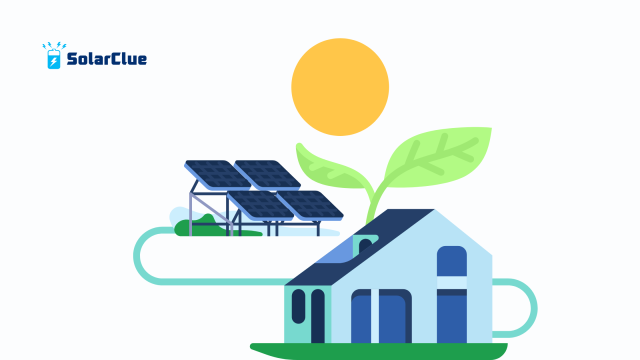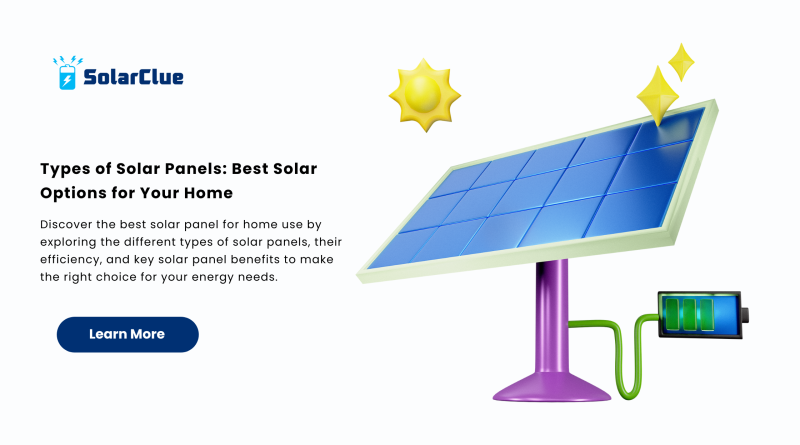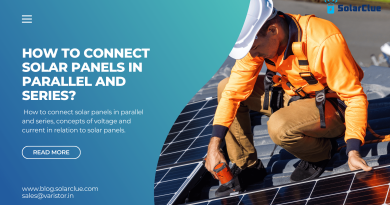Types of Solar Panels: Best Solar Options for Your Home
Choosing the best solar panel can be a game changer for both your electricity bills and the planet. As solar technology continues to evolve, understanding the types of solar panels available today helps homeowners make informed decisions. Whether you’re interested in Solar Energy savings or aiming to increase your property value, this guide has you covered.
Table of Contents
- 1 1. Monocrystalline Solar Panels (Mono-SI)
- 2 2. Polycrystalline Solar Panels (Poly-SI)
- 3 3. Thin-Film Solar Panels
- 4 4. PERC (Passivated Emitter and Rear Cell) Panels
- 5 5. Bifacial Solar Panels
- 6 Comparing Solar Panel Types
- 7 Solar Panel Benefits
- 8 How to Choose the Best Solar Panel for Home
- 9 What Affects Solar Panel Efficiency?
- 10 Top Long-Term Investment Tips
- 11 Popular Myths About Solar Panels Debunked
- 12 Government Incentives and Subsidies
- 13 Maintenance of Solar Panels
- 14 Conclusion: Find the Best Solar Panel for You
- 15 FAQs
1. Monocrystalline Solar Panels (Mono-SI)
What Are Monocrystalline Panels?
Monocrystalline panels are made from single-crystal silicon, making them the most efficient solar panel type in today’s market.
Why Choose Monocrystalline?
- High Solar Panel Efficiency (15%-22%)
- Sleek black appearance
- Great for homes with limited roof space
Ideal For:
Those looking for the best solar panel for home with maximum performance in smaller areas.
2. Polycrystalline Solar Panels (Poly-SI)
What Are Polycrystalline Panels?
These are made from silicon fragments melted together, resulting in a less uniform appearance but lower cost.
Benefits of Polycrystalline Panels
- Lower upfront costs
- Moderate Solar Panel Efficiency (13%-16%)
- Blue hue and shiny look
Best For:
Budget-conscious users seeking solar panels for large installations.
3. Thin-Film Solar Panels
What Are Thin-Film Panels?
Composed of various materials like cadmium telluride or amorphous silicon, these panels are lightweight and flexible.
Advantages of Thin-Film
- Lightweight and flexible
- Easy installation
- Aesthetic appeal for certain applications
Use Cases:
Best suited for commercial buildings and unconventional rooftops.

4. PERC (Passivated Emitter and Rear Cell) Panels
Advanced Solar Technology
PERC panels are an improved version of monocrystalline with an extra layer for better sunlight absorption.
Key Features
- Higher energy yield
- Improved temperature tolerance
- Ideal for hot climates
Who Needs These?
Homeowners in warmer regions needing more efficient solar power system.
5. Bifacial Solar Panels
How Bifacial Panels Work
These solar panels absorb sunlight from both sides, increasing energy output.
Advantages
- More energy per panel
- Enhanced ground reflectivity performance
Best Applications:
Commercial and residential setups with high reflective surfaces.
Comparing Solar Panel Types
| Type | Efficiency | Cost | Appearance | Best For |
|---|---|---|---|---|
| Monocrystalline | High | Higher | Black | Homes with limited roof space |
| Polycrystalline | Medium | Affordable | Blue | Budget-friendly large installs |
| Thin-Film | Low-Medium | Low | Thin & light | Special architectural projects |
| PERC | Very High | High | Black | Hot climates |
| Bifacial | High | High | Dual-side | Reflective surface areas |
Solar Panel Benefits
1. Cost Savings
Lower energy bills and net metering benefits make solar power an excellent long-term investment.
2. Environmental Impact
Using solar energy significantly reduces carbon emissions.
3. Energy Independence
Generate your own power, reducing reliance on the grid.
4. Increase Property Value
Homes equipped with solar panel for home setups often have higher resale values.
How to Choose the Best Solar Panel for Home
- Consider roof space and direction
- Compare energy needs vs. output
- Check budget constraints
- Look for warranties and durability
What Affects Solar Panel Efficiency?
1. Type of Panel
Monocrystalline and PERC panels offer the highest solar panel efficiency.
2. Temperature Coefficient
Panels perform differently under various temperatures. Choose accordingly.
3. Angle and Orientation
Ensure your solar panels face the right direction for optimal sun exposure.
Top Long-Term Investment Tips
- Opt for PERC or Monocrystalline for better ROI
- Use smart inverters to track efficiency
- Choose reputed installers like solarclue.com
Popular Myths About Solar Panels Debunked
- Myth: Solar panels don’t work on cloudy days. Truth: They still generate power, albeit less.
- Myth: Too expensive. Truth: Prices have dropped significantly and subsidies exist.
Government Incentives and Subsidies
Many regions offer incentives, rebates, and tax credits to promote solar power adoption. Visit blog.solarclue.com to explore these opportunities.
Maintenance of Solar Panels
- Clean them 2–3 times a year
- Monitor system performance regularly
- Annual inspections ensure longevity
Conclusion: Find the Best Solar Panel for You
Now that you understand the types of solar panels and their uses, you’re ready to make a smart, sustainable energy choice. Whether you prefer monocrystalline, polycrystalline, or thin-film, the right panel can revolutionize your energy independence and utility bills.
Want more guidance? Take your next step toward clean energy by visiting solarclue.com and reading insightful guides at blog.solarclue.com.
FAQs
1. What is the most efficient type of solar panel?
Monocrystalline and PERC panels currently offer the highest solar panel efficiency, often exceeding 20%.
2. Which solar panel is best for home use?
The best solar panel for home typically depends on space, budget, and climate. Monocrystalline is often the top choice.
3. Do solar panels work during cloudy weather?
Yes, solar panels still work during cloudy conditions, although output may be reduced.
4. How long do solar panels last?
Most solar panels have a lifespan of 25–30 years with proper maintenance.
5. Can solar power completely replace electricity?
With a robust solar power system, many homes can become energy-independent, especially when combined with battery storage.



